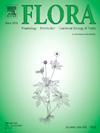Variation in leaf gall pigmentation in Cassava (Manihot esculenta, Euphorbiaceae) and its associations with structural host traits
IF 1.8
4区 生物学
Q3 ECOLOGY
引用次数: 0
Abstract
Cassava (Manihot esculenta, Euphorbiaceae) hosts various gall-inducing organisms, such as Iatrophobia brasiliensis (Cecidomyiidae, Diptera), which induce both white‒green and purple-leaf galls. In this study, we aimed to understand the relationship between gall structure and histochemistry with the occurrence of purple coloration in galls. Therefore, nongalled leaves of the 3rd node (n = 5) and mature white–green and purple galls (n = 5 each) were collected. Fragments of the median region of leaves (petiole and leaf blade) and of the galls were evaluated fresh and/or included in Historesin. Starch, reducing sugars, lipids, proteins, phenolics and alkaloids were histochemically evaluated in the galls. The galls assume the same pigmentation from petioles (white‒green or purple) of each M. esculenta individual, which are the mandatory intraspecific traits that determine its variation. Both white–green and purple galls have a uniseriate epidermis, with a thin cuticle and visually rare stomata. The cortex is exclusively parenchymatic and comprises an outer and inner cortex. The vascular bundles are collateral. The purple galls have subepidermal layers containing larger cells that act as sites for pigment accumulation alongside the epidermis. The occurrence of reducing sugars in the outer cortex was exclusive to purple galls, same for proteins and alkaloids in vascular bundles for white–green galls. The purple phenomenon of M. esculenta galls appears to be related to intraspecific variations in the plant species, resulting from a metabolic continuum with the petiole. Anthocyanin production seems to be sustained by the influx of sugars into the outer cortex of purple galls.
木薯(Manihot esculenta, Euphorbiaceae)叶片胆色素沉着的变异及其与寄主结构性状的关系
木薯(Manihot esculenta, Euphorbiaceae)寄主各种胆囊诱导生物,如巴西蝇蛆(cecidomiidae,双翅目),可诱导白绿色和紫色叶子的胆囊。在本研究中,我们旨在了解胆囊结构和组织化学与胆囊紫色发生的关系。因此,收集第3节的未结叶(n = 5)和成熟的白绿色和紫色瘿(n = 5)。叶片中间区域(叶柄和叶片)和瘿的碎片被评估为新鲜和/或包含在组织树脂中。淀粉、还原糖、脂质、蛋白质、酚类物质和生物碱在胆囊中进行组织化学评价。这些瘿具有相同的叶柄色素(白绿色或紫色),这是决定其变异的强制性种内特征。白绿色和紫色的瘿都有单胚层表皮,有薄角质层和视觉上罕见的气孔。皮层完全是实质的,包括外皮层和内皮层。维管束是侧枝。紫色瘿有表皮下层,其中含有较大的细胞,这些细胞在表皮旁作为色素积累的场所。外皮层还原糖只出现在紫色胆囊中,白绿色胆囊维管束中的蛋白质和生物碱也出现在紫色胆囊中。紫茎草瘿的紫色现象似乎与植物种内变异有关,这种变异是由叶柄代谢连续体引起的。花青素的产生似乎是通过糖流入紫色瘿的外层皮层来维持的。
本文章由计算机程序翻译,如有差异,请以英文原文为准。
求助全文
约1分钟内获得全文
求助全文
来源期刊

Flora
生物-植物科学
CiteScore
3.30
自引率
10.50%
发文量
130
审稿时长
54 days
期刊介绍:
FLORA publishes original contributions and review articles on plant structure (morphology and anatomy), plant distribution (incl. phylogeography) and plant functional ecology (ecophysiology, population ecology and population genetics, organismic interactions, community ecology, ecosystem ecology). Manuscripts (both original and review articles) on a single topic can be compiled in Special Issues, for which suggestions are welcome.
FLORA, the scientific botanical journal with the longest uninterrupted publication sequence (since 1818), considers manuscripts in the above areas which appeal a broad scientific and international readership. Manuscripts focused on floristics and vegetation science will only be considered if they exceed the pure descriptive approach and have relevance for interpreting plant morphology, distribution or ecology. Manuscripts whose content is restricted to purely systematic and nomenclature matters, to geobotanical aspects of only local interest, to pure applications in agri-, horti- or silviculture and pharmacology, and experimental studies dealing exclusively with investigations at the cellular and subcellular level will not be accepted. Manuscripts dealing with comparative and evolutionary aspects of morphology, anatomy and development are welcome.
 求助内容:
求助内容: 应助结果提醒方式:
应助结果提醒方式:


